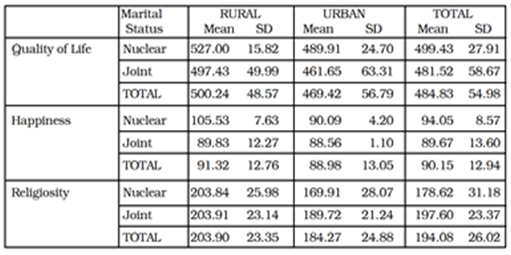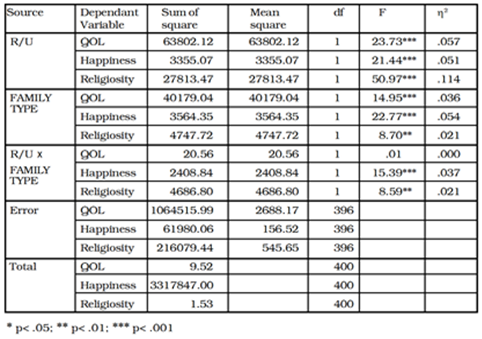-
Paper Information
- Paper Submission
-
Journal Information
- About This Journal
- Editorial Board
- Current Issue
- Archive
- Author Guidelines
- Contact Us
International Journal of Applied Psychology
p-ISSN: 2168-5010 e-ISSN: 2168-5029
2016; 6(4): 94-99
doi:10.5923/j.ijap.20160604.03

Structural Influence of Family on Religious Orientation, Quality of Life and Happiness
Manju Kumar , P. S. N. Tiwari
Department of Psychology, DDU Gorakhpur University, Gorakhpur, India
Correspondence to: Manju Kumar , Department of Psychology, DDU Gorakhpur University, Gorakhpur, India.
| Email: |  |
Copyright © 2016 Scientific & Academic Publishing. All Rights Reserved.
This work is licensed under the Creative Commons Attribution International License (CC BY).
http://creativecommons.org/licenses/by/4.0/

The study examines the influence of family structure and family experiences on psychological differentiation in Indian environmental context. Two types of families; viz., joint and nuclear were selected from the rural and urban region of India. 400 male and female participants were administered Religious orientation questionnaire, WHO-QOL questionnaire and Oxford happiness inventory tests. Multivariate ANOVA performed on differentiation scores revealed significant effects. Family effect was statistically significant on religiosity, quality of life and happiness. The data suggests a strong trend in the expected direction. The findings have been discussed in terms of the characteristic family patterns of Indian subcontinent.
Keywords: Religiosity, Spirituality, Family structure, Family type, Quality of life, Happiness, Environment, Rural, Urban
Cite this paper: Manju Kumar , P. S. N. Tiwari , Structural Influence of Family on Religious Orientation, Quality of Life and Happiness, International Journal of Applied Psychology, Vol. 6 No. 4, 2016, pp. 94-99. doi: 10.5923/j.ijap.20160604.03.
1. Introduction
- The family is the foundational institution in societies- an institution which is a site of identity, emotion, cultural expression, care, despair, productive labor, systematic violence repression and domination in ways that other institutions are not. It is also foundational in that contestations over life and culture begin here. In India its position has been central and critical.The anthropologist George Murdock's definition of the family is "The family is a social group characterized by common residence, economic co-operations and reproduction. It includes adults of both sexes, at least two of whom maintain a socially approved sexual relationship and one or more children, own or adopted of the sexually cohabiting adults." Sociologist Aileen D. Ross's definition of family includes physical, social and Psychological elements of family life. According to her, family is a group of people usually related as some particular type of kindred who may live in one household and whose unity resides in patterning of rights and duties, sentiments and authority. The social structure and the cultural traditions of countries and small societies are the factors that affect psychological phenomenon and shape human behavior according to cultural institutions, norms, values, language, history and traditions (Georgas. J., 2003).These three concepts are employed by anthropologists and sociologists as well as psychologists in discussing the family structure and function. The structure refers to the number and positions of the members of the family and the function refers to how the family members satisfy their physical and psychological needs in order to maintain the family and to survive as a group. All societies have unwritten social constructs and values regarding the proper roles of family members, although there are individual differences in all societies as to agreement or disagreement with those roles.Concept of Family StructureThe different family types or structures are based on anthropological sociological studies of small and large societies throughout the world. In Indian family system, a family is classified mainly into two parts viz.; joint family system and nuclear family system. According to Iravati Karve (1953), “Joint family is a group of people who generally live under one roof, who eat food cooked at one hearth, who held property in common and who participate in common family worship and are related to each other as same type of kindred.” The term joint family is also common in United States to refer to extended family or stem family. Similarly, the nuclear family is commonly used in the United States of America to refer to conjugal families or elementary family. However, in Indian context, a nuclear family includes two married parents of opposite genders and their unmarried biological or adopted children living in the same residence and sharing the values, duties and responsibilities of the family unit. Another definition of Indian nuclear family is, “One or both parents with children” (Ross’s A.D.; 1961).Family structure and religiosity India is rich in its traditional values and customs, and one of the most religiously diverse nations in the world, with some of the most deeply religious societies and cultures. Religiosity means “faith in a power beyond a person’s reach whereby he seeks, to satisfy emotional needs and gains stability of life and which he expresses in acts of worship and service” (Galloway, 1956). Religious orientation is the term employed by psychologists to refer to the way in which a person practices or lives out his or her religious beliefs and values (Batson & Ventis, 1982). Religion still plays a central and definitive role in the life of many of its people. "It forms the basic unit of social organization as in the society it's the responsibility of the family as a social organization to internalize the society's culture and Indian family structure is largely tied to religious beliefs (Das and Kemp, 1997). If a parent is religious and instills religious values in his or her child, then the child is more likely to be religious as well. And the more religious a child is, the more in touch they are with their heritage and culture. This aspect is consistent with the literature review which suggested that religion plays a large role in family life (Das and Kemp 1997, Sodowsky and Carey 1997, Das 1987, Harker 2001). Many religious obligations and duties are fulfilled through families (Hodge 2004).The mother’s level of perceived religiosity was always positively associated with inter-generational family conflict. This means that the high religiosity level of the mother, may mean high level of heritage, culture, and more expectation put upon their child to maintain the heritage, culture causing conflict.Family structure and quality of lifeThe quality of life may be defined as “the degree to which a person enjoys the important possibilities of his/her life” (Alexander, Moreira-Almeida et al., 2006). The size and structure of the family and its capacity to sustain itself has played a critical role in how children are raised, their level of formal education and their way of thinking which affects the quality of life. There are concerns how changes in family structures influence the health & well-being and quality of health outcome of the population. While some studies examine parent-child relationship and health (Bagley et al. 2006, Barrett and Turner 2006, Bjarnason et.al. 2003), there have been few studies of multigenerational composition effect. Previous studies have indicated association of large family composition and health behavior in different communities (Ferrer et al. 2005, Green et al. 2003). There are concerns regarding the further influences of multigenerational family composition on measures of health status and quality of life. Some studies have also suggested that there are association between multigenerational family composition and supportive environments (Kaplan et al. 2006, Steptoe et al. 2000, Takada et al. 2004). It would be of interest to explore the possible impacts of supportive environment prevalent in multigenerational families on quality of life measures. Family structure and happinessLike most psychological phenomena, happiness is only partially reflected in behavior. Happiness cannot be inflicted upon us. Happiness is an extremely personal and subjective phenomenon and feeling. Every family is based on human impulses of mating, motherly devotion and parental love and care. The members of a family have emotional attachment with each other. Love between husband and wife, parents and children makes the family an institution of self-sacrifice.Happiness in the psychological sense has always been an important concern of researchers. It is a state of mind and is often implied as a psychological state following the gratification of some important human needs or desires (Diener, 1984).We are happy when we are secure. The ingredients that underpins our sense of well-being and complements our happiness is our faith in the family and abiding closeness that knits our social structure together and rich bounding of individuals as members of families and communities. Sense of security and well-being is a major factor in our enjoyment of happiness and this may come when being in a tightly knit family.The objective of the study was to investigate the relationship of family structure, religiosity, quality of life and happiness in different environmental conditions in Indian society. Specifically, the study attempts to look at the relationship of religiosity, quality of life and happiness in joint and nuclear families.
2. Method
- A cross-sectional descriptive design was used to explore the relationships among quality of life, happiness and religious orientation.Sample: The sample consisted of 400 randomly selected people from different religions in rural and urban population residing in various locations of India. Of the total sample 50% (n=200) were from rural background and 50% (n=200) were from urban background. Measures: For measuring quality of life WHOQOL-100 & WHOQOL SRPB-32 instrument was used. This scale was developed and standardized by a team of Department of mental health and substance, World Health Organization (WHO), Geneva, Switzerland in 2002. Both these scales consist of a total of 132 items. These items are divided into six domains. The questionnaires were translated in simple Hindi language. Statements were made small and easy to understand. It was checked by six subject experts and proved to be good in the pilot study.Happiness was measured by using Oxford happiness questionnaire developed and revised by psychologists Hills & Argyle (2002). The questionnaire had 29 items and discrimination power (DP) of 0.91. This questionnaire was self-translated in Hindi language. The statements were made simple & short and were converted into a four point rating scale for precise concept and accurate scoring.For measuring religious orientation a 50 items five point Likert scale having 17 dimensions was self-developed during the course of investigation. The domains included are: Intrinsic religiosity i.e.; prayer & worship, future life, spirit and spirit world, general religiosity, personal religious belief, God as judge, universal truths, religious practices (yoga and meditation), and personal religion. Extrinsic religiosity i.e.; Nature of God, formal religion, attitude towards priests, civil and social religion, the daily and occasional rituals, religious education, attitude towards scriptures, attitude towards religious places. The DP of the scale was found to be 0.84.Procedure: All the participants were contacted personally and provided a consolidated questionnaire having WHOQOL, Oxford happiness questionnaire and Religious orientation questionnaire (self-developed). Since all the participants were literate, there was no problem in their understanding the questions. The data was collected individually. The subjects were interviewed to make the observations more precise and accurate. They were also asked to express their views and suggestions.The filled protocol was re-examined and the scoring was done as per manual instruction for each questionnaire. Master chart was prepared and the data was analyzed statistically.
3. Results
- Table 1 reports the means & SD of quality of life, happiness and religiosity as a function of family type and environmental setting. Table 2 shows the summary of MANOVA. It is evident from the tables that the interaction of happiness (F(1,396) = 15.39, p< .001,
 and religiosity reached significance (F(1,396) = 8.59, p< .01
and religiosity reached significance (F(1,396) = 8.59, p< .01  for family type and location showing that family type has significant impact on happiness and religiosity of a person. However, interaction of family type and location could not reach significance level (F(1,396) = .008, p> .05,
for family type and location showing that family type has significant impact on happiness and religiosity of a person. However, interaction of family type and location could not reach significance level (F(1,396) = .008, p> .05,  for QOL. The main effect of family type reached the significance level (F(1,396) = 14.95, p<.001,
for QOL. The main effect of family type reached the significance level (F(1,396) = 14.95, p<.001,  for QOL suggesting that the QOL of nuclear family subjects (M=499.43) is significantly better than joint family subjects (M=481.52) (fig. 1). For happiness the main effect of family type reached the significance level (F(1,396) = 22.77, p<.001,
for QOL suggesting that the QOL of nuclear family subjects (M=499.43) is significantly better than joint family subjects (M=481.52) (fig. 1). For happiness the main effect of family type reached the significance level (F(1,396) = 22.77, p<.001,  suggesting that the happiness of nuclear family subjects (M=94.05) is significantly better than joint family subjects (M=89.67) (fig. 2). For religiosity also the main effect of family type reached the significance level (F(1,396) = 8.70, p< .01,
suggesting that the happiness of nuclear family subjects (M=94.05) is significantly better than joint family subjects (M=89.67) (fig. 2). For religiosity also the main effect of family type reached the significance level (F(1,396) = 8.70, p< .01,  suggesting that the religiosity of joint family subjects (M=197.60) is significantly better than their counterpart nuclear family subjects (M=178.62) (fig. 3).
suggesting that the religiosity of joint family subjects (M=197.60) is significantly better than their counterpart nuclear family subjects (M=178.62) (fig. 3).
|
|
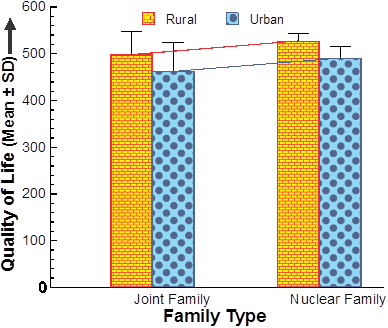 | Figure 1. Mean scores of quality of life as a function of family type |
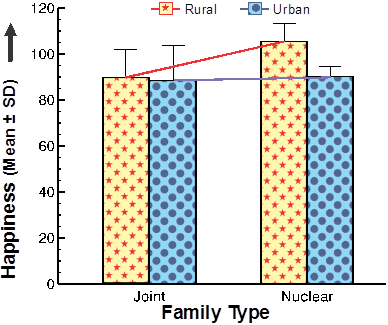 | Figure 2. Mean scores of happiness as a function of family type |
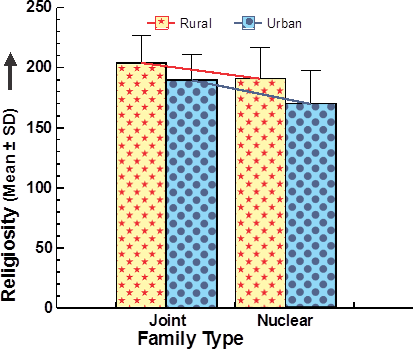 | Figure 3. Mean scores of religiosity as a function of family type |
 for QOL suggesting that the QOL of rural nuclear family subject (M=527.00) and urban nuclear family subject (M=489.91) is significantly better than their counterpart rural joint family subject (M=497.43) and urban joint family subject (M=461.65). For happiness also the main effect of family type reached the significance level (F(1,396) = 21.44, p< .001,
for QOL suggesting that the QOL of rural nuclear family subject (M=527.00) and urban nuclear family subject (M=489.91) is significantly better than their counterpart rural joint family subject (M=497.43) and urban joint family subject (M=461.65). For happiness also the main effect of family type reached the significance level (F(1,396) = 21.44, p< .001,  for location suggesting that the happiness of rural nuclear family subject (M=105.53) and urban nuclear family subject (M=90.09) is significantly better than their counterpart rural joint family subject (M=89.83) and urban joint family subject (M=88.56). For religiosity the main effect of family type reached the significance level (F(1,396) = 50.97, p<.001,
for location suggesting that the happiness of rural nuclear family subject (M=105.53) and urban nuclear family subject (M=90.09) is significantly better than their counterpart rural joint family subject (M=89.83) and urban joint family subject (M=88.56). For religiosity the main effect of family type reached the significance level (F(1,396) = 50.97, p<.001,  in location showing that the religiosity of rural nuclear family subject (M=203.84) and urban nuclear family subject (M=169.91) is significantly better than their counterpart rural joint family subject (M=203.91) and urban joint family subject (M=189.72).
in location showing that the religiosity of rural nuclear family subject (M=203.84) and urban nuclear family subject (M=169.91) is significantly better than their counterpart rural joint family subject (M=203.91) and urban joint family subject (M=189.72).4. Discussion
- Family is the first learning Centre of the social life. The main psychological factors which govern a family are parental care, emotional attachment, sense of responsibility, acceptance of self-discipline, mutual financial need as well as love and respect among each member. Indian families are widely known to be of two basic kinds based on the number and type of people living together under one roof: nuclear and joint.In both family types, good family relationships such as care and warmth from spouses and family members could lead to closeness, sense of security and perceived love and then to happiness in life and a good quality of life. Quality of life is an individual factor. It depends upon the happiness and contentedness of an individual, which in turn depends upon the people around the individual. Hence, the role of family. If there is no strong relation to other family members, people feel lonely and depressed and that reduces their quality of life. Netuveli et al. (2006) studied the quality of life at older ages, and found that the quality of life was improved by having trusting relationships with family and friends, frequent contacts with friends, life in a good neighborhoods. Also, Nanthamongkolchai and Munsawaengsub (2009) found that family relationships had an influence on happiness among elderly females, which is congruent with the present study.The results coming from available data indicates that higher religiosity is found in joint family members than nuclear family members. The findings are supported by Takeda et al. (2004) who showed that joint family setting provides a number of rewards, including social support, prestige, greater control and power within the family. Since joint family members get all these privileges so easily, they usually attribute them to a higher order and become more religious. The factor of religiosity shows importance in predicting the happiness (Sharma and Malhotra, 2010). They found that, religiosity accounted for 3% of variance each in nuclear family and rural sample. They showed that religious people are contented with life. Religiosity is a cushion and a hope that provides people support through thick and thin, and strengthens the inner self and helps the people to overcome any problem with equanimity (Myers 2000, Abdel-Khalek, 2006).A harmonious joint family set-up can be a boon. It can provide a wonderful support system emotionally and financially. In an ideal state, one can share both, one’s triumphs and failures with others. For a joint family system to work, the members learn to adjust, to overcome their jealousies, to develop mutual respect between the generations and to learn to give each other space. In a joint family members get mature early and tend to get serious in their dealings. Maintaining harmony in a joint family in today’s materialistic world is a difficult task, as more the number of members more the clash in everybody’s habits and interests. Daily activities and lifestyle is affected by people living with us in our family, and therefore large family structures are more likely to facilitate a traditional Indian lifestyle, due to presence of aged members.As indicated by the results of this study, the quality of life is better in nuclear family subjects. A nuclear family is a small family having only a few members, so, one has less duties and responsibilities. One can have much time to do other works and enjoy life. A nuclear family is free from noise and disturbances. It is also found that living in nuclear family unit is associated with better health among men as compared to women, than other family structures (Denton and Walters 2004). Besides, it was also found that in rural environment, people are more religious and their quality of life is better than their counterpart urban family subjects, regardless of their religiosity. Rural environment, with its fresh air and closeness to nature, has many health effects, which seem to be both physical and mental. People who live in rural areas find satisfaction in life partly due to good environmental conditions, where they live in. Moreover, they have good social support and family relationships which is the culture of the rural area in India.So basically, every family structure whether joint or nuclear has distinct advantages and disadvantages for human life and development.A joint family has the advantage of having better social support for members, more maturity, closeness to traditions, and respect for elders. But it falls short in the fields of happiness, freedom, attention to children and the members tend to have more responsibilities.A nuclear family, on the other hand, enjoys the benefits of more happiness, freedom, attention to children and less responsibilities. But has the problems of lower tolerance among individuals, lower maturity, lack of adjustment capabilities and self-centeredness.The findings are indicative that Indian society in the 21st century has become a fast changing society. The needs of a person are growing larger day by day which has forced a person opt for nuclear family structure. The nuclear family unit provides a closeness which a joint family (multi-generational family) cannot. The smaller size allows for individualized attention towards children. The nuclear model will not guarantee success or happiness, but it can provide a basis to obtaining these ideals. After all no family structure is perfect.
 Abstract
Abstract Reference
Reference Full-Text PDF
Full-Text PDF Full-text HTML
Full-text HTML